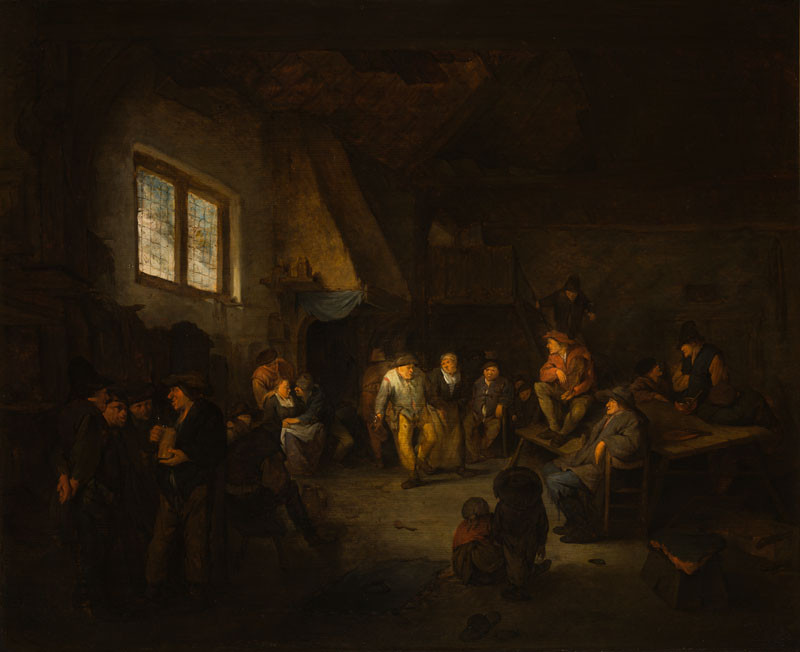
The picture represents the mirthful merrymaking of a village community. The scene is set in a village inn, the high walls and ceiling of which take up nearly half of the height of the picture. The figures of the farmers thus seem diminutive, which turns them into small and contented puppets. This impression is further enhanced by the slightly elevated vantage point of the viewer into the scene. From top left, light filters into the gloomy room through a pair of windows, illuminating the center of the picture. Accompanied by a fiddler, a pair of dancers shuffles clumsily along. Grouped in a semi-circle around them are several additional figures, some watching the dancers, others engaged in conversation. Jugs with beer and wine, a cauldron of soup and a cutting board with a knife indicate, that their bodily needs are being seen to. The picture represents an early work by the artist, dating to the early 1650s. Both the composition and theme of the picture are firmly rooted in the tradition of the peasant genre of Bega’s teacher Adriaen van Ostade (1610-1685). The warm ochre tones and the manner of the composition, which consists of a large number of figures, are typical of this style. In his later work, Bega opted rather for a colder palette of grayish tones, concentrating on only a few figures rendered in great detail. Instead of a rough satire of the merry peasants such as one knows from Flemish art, and particularly the work of the followers of Pieter I Bruegel, in Ostade and Bega there appears a kind of rural idyll, contributing to which is the moving of the scene indoors. Motifs of disorder, such as the overturned bench on the right side of the painting, and the objects strewn on the floor, such as a spoon, or the single slipper visible in the foreground, strike one as having a decorative rather than moralizing purpose. Instead of the customary crude scenes of vomiting drunkards, Bega shows the consequences of consumption of alcohol in the single figure of a harmless peasant asleep at a table. The importunity of the peasant shown embracing a woman by the fireplace in front of an observing companion in the left section also seems relatively restrained. Among the stock repertory of the depictions of village inns of Adriaen van Ostade and his followers is also the aforementioned central scene featuring the dancing couple and a fiddler, here sitting in an elevated spot on the table. Numerous sources attest not only to the fact that the violin was not greatly valued in the 17th century, but also show that it was used exclusively in dance music as performed by itinerant musicians. Bega's fiddler is holding his instrument as was customary at the time, i.e., not under the chin, but supported against his shoulder, which is convenient for a lively and rhythmic manner of playing. The indifferent reputation of the violin at the time went hand in hand with the condemnation of dancing as sinful, vain and dissolute, a pastime whose frivolous glances and physical contact as well as wild movements were seen as conducive to further debauchery. Even though the amusements portrayed by Bega do not strike one as particularly profligate, one may still perceive a central moral message behind the visual representation. This is attested by both of the figures in the shadow in the foreground (the repoussoir) - a young girl and boy watching the whirling dancers, hardly to be taken as an instructive example of good behavior.
